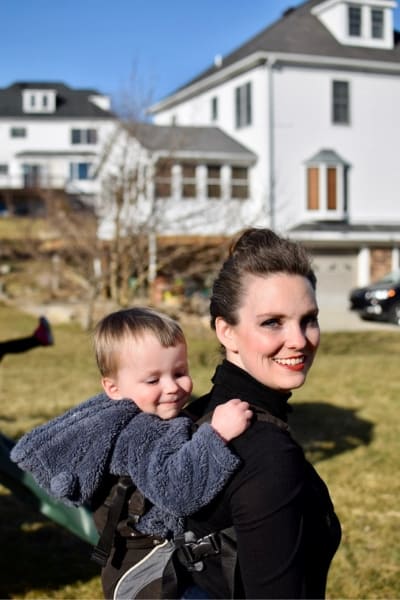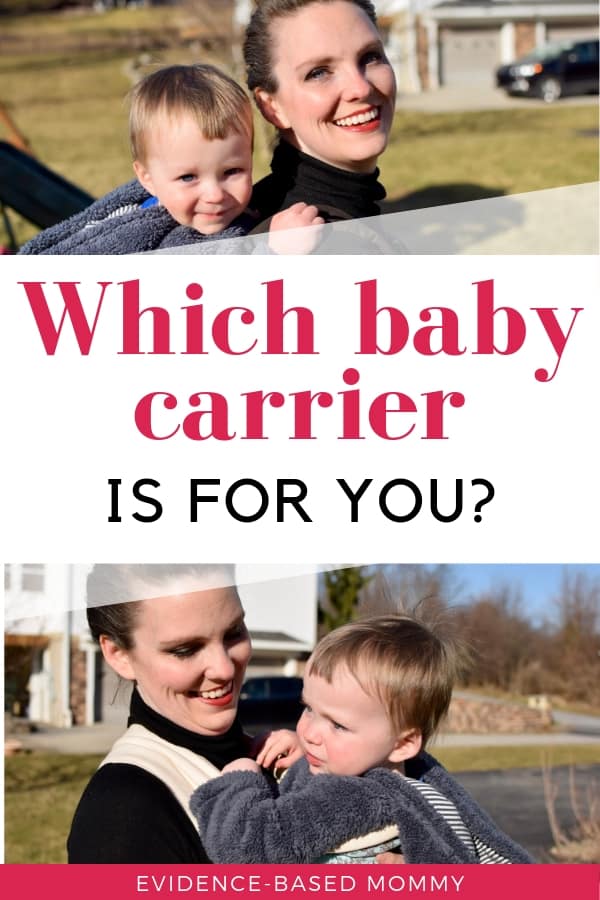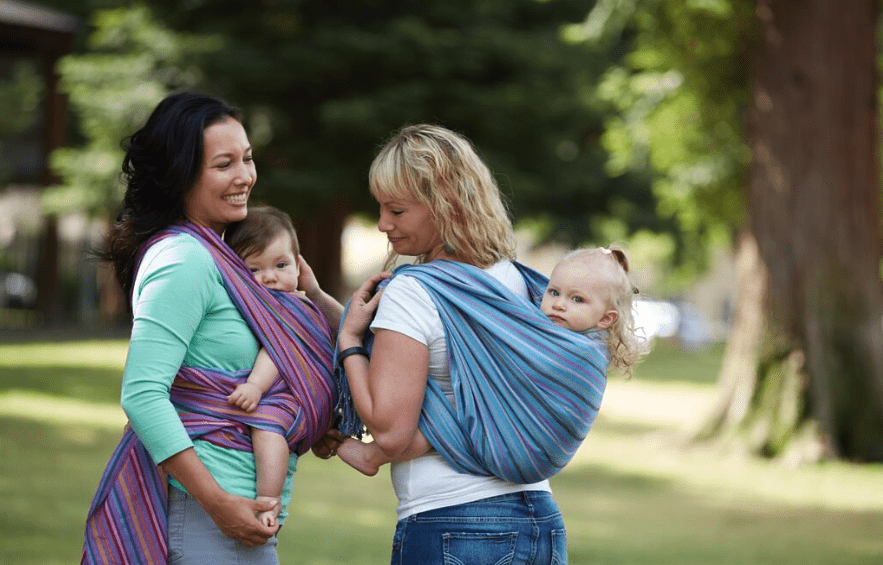When it comes to the best baby carriers, there are a few different types to choose from. There are wraps, slings, mei tais, and more. There are pros and cons for these different types of baby carriers. That means the best baby carrier for you will depend on your needs and what works best for you and your baby.
Honestly, a baby wrap or carrier is one of my top must-haves for when you first come home with your baby. It makes it so much easier to bond while also living your life.
For example, different ages and sizes of babies do better in different carriers. And on top of that, different carrier types lend themselves better to different situations.
If you’re already feeling overwhelmed, I’m here for you! After trying all different types of baby carriers for over 9 years, I’ve got a pretty good idea of what the best baby carriers are.
In this post, we’ll take a closer look at the different types of baby carriers available, and discuss the benefits of each one. We’ll also help you decide which type of carrier is right for you and your little one. Let’s get started!
Table of Contents
Different types of baby carriers
Before we get started on the best baby carriers, a note: I know we all want to save money. But a baby carrier is not the item to do it on! Not only can the wrong carrier damage your baby’s hips, but I’ve found that cheaper carriers cause more back and neck strain for me, leading to soreness and even killer headaches after wearing. So make the investment now and your back will thank you later.
RELATED: Pros and cons of babywearing
While I’ve got more details on each type of baby carrier below, I also have a handy table if you want a quick reference for them.
Stretchy wraps
If you’re a new parent, you may have heard about stretchy wraps as an option for carrying your baby. These stretchy fabric carriers are perfect for very small babies, as they provide ample support. And because they’re basically just a long piece of cloth, they can be easily adjusted to fit your unique shape.
Plus, stretchy wraps are breathable and can be worn in multiple positions, giving both parent and baby comfort during wear. Plus, these are one of the easier wraps to breastfeed in. It’s perfect for when your baby is distractible during nursing sessions.
RELATED: Helping your distracted baby with nursing
Stretchy wraps are unique in that you tie them on yourself before you put the baby in. That fact alone takes a lot of the pressure off of trying to tie your wrap – you don’t need to worry about dropping your baby in the process!
When you have a tiny baby, they can be wrapped up in a little froggie position, with their legs curled up inside the wrap. As they grow, you can change the position so that their legs stick out of the bottom of the wrap.
The main downside of a stretchy wrap is that babies grow out of them quickly (by about 6-9 months). By then, they are too heavy and weigh the stretchy wrap down too much.
If your stretchy wrap starts to feel stretched out or lose its elasticity after frequent use and your baby is still small enough for it, simply throw it in the wash to bring it back to its original form. It’s kind of like how a pair of jeans will tighten up after washing.
Overall, stretchy wraps offer a convenient and comfortable way for parents to keep their little one close during those early months, especially when your little one is cluster feeding.
While the Moby is fine (and easier to find in store), I really like the Boba wrap best. The Boba wrap is more light weight and therefore much cooler in summer. Plus, the Boba holds its shape better than the Moby. That way, you can pop your baby in and out of the wrap as needed, and you can even leave it tied on when you’re not wearing your baby. Plus, that lets you use the Boba for a few more months than the Moby.
Think a stretchy wrap is for you? Check the Boba out here.
Woven wraps
Woven wraps look and function very similarly to stretchy wraps, but they… don’t stretch (shocker, I know). However, this makes them work differently in several ways.
While a stretchy wrap is made with stretchy material, such as cotton or spandex, a woven wrap is made with tightly woven fabric, like linen or silk. These materials are lighter weight and cooler than a stretchy wrap, which is definitely a plus in hot Georgia summers. With that said, woven baby wraps are probably the best baby carriers for hot weather.
Woven wraps also have more support and can hold heavier babies better than stretchy wraps, making them a great option for newborns and toddlers alike.
However, this extra support does mean that woven wraps require a bit more technique to learn how to use properly. The main issue is that you have to tie your the wrap to you while your baby is in it, which definitely adds a layer of challenge.
With that said, woven wraps offer many benefits for those willing to put in the time to learn how to use them properly. You can check them out here.
Woven wraps for baby carrying in the water
I got the Beachfront Baby wrap when we went to the beach when my third was only three months old, and I’m SO glad I did! This light weight woven wrap, with its mesh and quick-drying fabric, is perfect for going out into water with your child (like hip-deep, don’t try to swim in it).
Plus, the material is naturally UV blocking, so the parts of your baby that’s covered will get an extra layer of sun protection.
The Beachfront Baby wrap is also helpful for taking a shower with your baby when they’re too little to sit up in the bottom of the tub on their own. So if you desperately need a shower but no one is available to hang on to the baby, this can be a great option. So just wrap up your baby, hop in, and soap up!
Soft structured carriers
Are you a new parent looking for the best baby carrier? Soft structured carriers (SSCs) might be your best bet.
Not only do they tend to be beginner-friendly, but they can also provide support for both parent and child. The straps and buckles provide a customizable fit, making things comfortable for you and your baby.
In fact, some SSCs (like the Ergobaby Omni 360) can carry your baby from the newborn stage all the way to 4 years old. So while this style of baby carrier may be pricier up front, it’s worth it because you can use them for so long.
Soft structured carriers are great because you can do both front and back carries with them.

While I wouldn’t necessarily say that soft structured carriers are the best baby carriers for men (because there’s really not a reason guys can’t use other carrier types), these carriers are often a favorite among dads. The straps and weight distribution make them comfortable to wear for extended periods of time. Plus, the adjustment straps make it simple to trade back and forth between two people (in case one parent gets tired and wants to trade out).
In fact, soft structured carriers are among the best baby carriers for back pain, as they distribute the baby’s weight evenly when adjusted correctly. Plus, many SSCs provide added lumbar support.
If you’re a casual hiker, these carriers are great for bringing your little one along on outdoor adventures. So don’t overlook the benefits of soft structured carriers – they could be the perfect pick for you and your baby.
Mei tais / meh dais
If you’re in the market for a baby carrier, the meh dai might be worth considering. Born out of traditional Chinese culture, it has been adapted and popularized in Western countries as a comfortable and versatile option for parents and caregivers.

Honestly, the mei tai is perhaps my favorite carrier type. I remember when I ordered my first mei tai for my oldest little girl. She was about 9 months old and had grown out of her stretchy wrap. She had a fever and was fussy and tired.
The wrap arrived, and I put it on and put my baby in it first thing. Almost immediately, she fell asleep. It was a miracle.
Unlike fully structured carriers that have rigid straps and buckles, the meh dai provides partial structure with a supportive panel and long straps that can be tied or secured in a variety of ways. This gives parents the freedom to customize their fit and carrying position, making it easy to switch between front, back, or hip carrying positions.
Perhaps because people are less comfortable with tie straps instead of buckles, it’s harder to find mei tais from bigger companies in the United States. However, there are some beautiful, well-made meh dais (like this one) on Etsy.
With its one-size-fits-all design and adjustable straps, the meh dai can easily accommodate different body types and growing babies. Mei tais are great for newborns all the way through toddlers.

Generally, you tie the mei tai around your waist first, then put your child in before wrapping the shoulder straps.
If you’re doing a back carry and don’t have anyone around to help you, you can start with the mei tai draped over a chair and your child sitting on it. Tie the waist straps, then stand up while holding the shoulder straps, adjust your little one, then secure the top.
If you’re looking for a unique and adaptable carrier option, give the meh dai a try.
Ring slings
A ring sling is a type of baby carrier that uses a long piece of fabric and two rings to create a supportive seat for your little one. The fabric is threaded through the rings, creating an adjustable shoulder strap, and then the baby is placed in the seat portion of the fabric.
One popular feature of ring slings is the ability to easily breastfeed while wearing them, as they can be loosened and moved to the side with minimal effort (a good nursing tank that’s easy to snap up and down makes this even more practical).
RELATED: Best nursing tanks and camis
Ring slings also allow for different carrying positions, from snug against your chest for tiny babies to sitting on your hip for toddlers.
I’ll be honest, lots of people love ring slings, but they don’t work for me personally. The fact that the baby’s weight is all on one shoulder creates back and neck strain for me, and I end up with a headache when I use it.
While ring slings might not be the best fit for every caregiver, for those who love them, they offer convenience and versatility in caring for their baby on-the-go. You can check them out here.
Hiking backpack carriers
When it comes to hiking with young children, a backpack baby carrier can be awesome. These carriers aren’t for daily use because they’re heavier and bulkier than the typical carrier. However, they create the most support and often have sun shades to protect your little one.
Not only does the backpack carrier provide comfortable support for both parent and child, but it frees up the parent’s arms for balance and stability on potentially rough terrain. It also allows for hands-free exploration, making it easier for both parent and child to enjoy the scenery and scenery along the hike. In addition, zippered pouches (like on the Osprey Poco Plus Backpack) allow you to carry water, snacks, diapers, and wipes easily.
Finding the right fit is crucial; make sure to measure your child’s height and weight before purchasing a carrier, and try out several different models before committing. Backpack carriers aren’t meant for tiny babies. Instead, they are meant for children at least 16 pounds (around 6 months or older)
It’s also important to practice at home before heading out on a hike, to ensure that both you and your child are comfortable in the carrier.
When used properly, a backpack baby carrier can open up a whole new world of outdoor adventures for you and your little one.
Conclusions on different types of baby carriers
I hope you found the best baby carrier for you and your little one. With all of the different types of baby carriers out there, it can be hard to decide which carrier is right for you.

But hopefully with your new knowledge of what to look for, you should be able to find the best baby carrier for your family. Questions? Let me know in the comments.
















Good to know!
Glad to help!
For parents, choosing the best baby carrier is an important and difficult task. The detailed information in this article provides a great deal of help and information. Such a great article!!